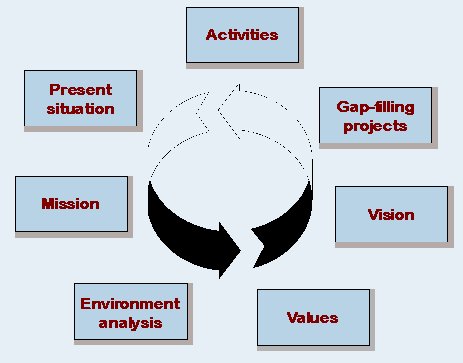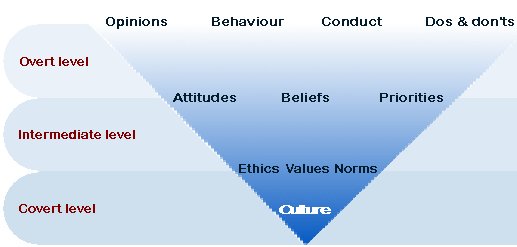Strategic Visioning and Corporate Culture
Paper originally presented at
BIMCO/Sohmen-Forum, Lisbon, 1999
Revised 2003
Bengt Schager, M. Sc.
Profil Schager & Co AB
Imagine what would happen if the top management in a company overnight became ill and couldn’t work for, say, three months? Would such a company be paralysed? Would it cease operating? Would it go bankrupt? Probably not, provided the company is basically healthy.
A healthy company would keep going, more or less as usual, for quite some time. People beneath the managerial level would assume and/or accept most of the responsibilities. They would have to make the necessary decisions and to find creative ways to continue the operations.
Individual employees would stand out and accept leadership, not because they are necessarily eager to, but because other people further out in the organisation still need guidance, because problems still have to be solved and because customers still expect to be served.
In other words, an otherwise healthy organisation would adapt to the loss of managers and maintain ”business as usual” for some time. Without professional management, however, one important capacity would be lacking: the organisation would cease to develop.
In studying companies that have been separated from their ordinary management, we can thus distinguish the following four characteristics:
1. Previously hidden competencies will probably be released, i.e. activated.
2. People will start taking new initiatives and voluntarily accept new responsibilities.
3. The company can survive for some time.
4. The company ceases to develop.
The conclusion must follow that the ordinary management may have the greatest impact on an organisation if they:
1. Concentrate their efforts on corporate development.
2. Facilitate for people to utilise their hidden capacities.
These two priorities can be achieved simultaneously by means of a process-oriented management approach. This paper deals with the two lessons mentioned above and outlines a process-oriented, step-by-step management approach towards corporate development parallel with nurturing a profitable company culture.
The development process runs through several steps where each step builds on the previous one. The process contains lots of analysing, discussions, thorough documentation and ongoing communication with the people. Graphically the steps can be described in the following way:

Fig.1. The steps of the development process from present situation to gap-filling projects.
The development process outlined here should be viewed as an ongoing, never-ending questioning of the corporate and cultural positions, aims, activities and directions. In such a process, a ”birds-eye view” of corporate activities can be both exciting and beneficial as it might reveal new information which differs from the day-to-day focus. To shift perspective from the daily ”what” we are doing to ”how” we are doing things can also be intellectually very challenging.
Start where you are
The first step for management is to analyse the business with the aim of finding facts about the company’s present position. The object is to define the company’s business or areas of business correctly so as to start building the change process on a solid, reality-based ground. The present position can of course be defined in several ways. It is therefore advisable to cover important areas such as the company’s position as regards the market, combinations of
products, financial strength, the present state of technology, the present customer structure and the like.
The objective of this analysis is to start drawing the map and to describe the essence of the actual business as carefully as possible.
When the areas of business are defined, questions concerning competitors and the company’s position relative to competitors can be dealt with. Reasonable factors in this positioning are details about leading competitors, competing technologies, technology leaders, productivity leaders and whether the company is in line with the heartbeat of the industry.
Preferably, the answers should be worked out by looking at the business from the outside, from the customers’ point of view. Such an approach makes it easier for management to describe the market as well as competitors and competing technologies.
When the position is established, the analysis should continue by establishing the purpose of the business and what customer demands the company is dedicated to fulfilling. The purpose of the business should be made concrete in a short, written description of the company’s Mission, a Mission Statement.
The Mission Statement should formulate the scope of the business and serve as a guide to the people and convey a message to the organisation about what aspects are prioritised, what aspects are chosen and not chosen, what business we are in and what business we are not in.
Analysing from the outside is important. Analysing a business from the inside creates a danger of ending up with missions stated in financial terms like ”maximising profits”. This should be avoided because it is a somewhat limited perspective and unfortunately not a long-term one. Logically, such a mission statement would result in a recommendation to sell the company, thus maximising the profit immediately.
The organisation will, however, probably survive with new owners and still need a raison d’être. For long-term survival, an organisation needs to develop by constantly interpreting, defining, understanding and fulfilling someone else’s needs; the better and more pro-active, the more competitive a company.
With the help of a well-formulated Mission Statement, the management is now able to distinctively analyse another dimension of the company’s position by making a SWOT analysis (analysis of Strengths, Weaknesses, Opportunities and Threats). This analysis helps to clarify both the potential and the vulnerabilities of the businesses.
The ideal situation for a company is to build upon its strengths, to compensate for or at least avoid exposure to weaknesses, to exploit opportunities and to eliminate or steer clear of threats.
When making the analysis, one should pay attention to the risks and pitfalls of basing the analysis upon common in-house biases. Needless to say, the more honest and critical the analysis is, the more realistic are the facts derived from it.
This analysis can also be supplemented with a discussion of environmental factors such as foreseeable changes and future trends that might possibly affect the business. Examples are potential changes in legislation or technology, market variations, political and social changes, attitude changes among the public and the like.
Values as signs of culture
The following and very useful step is to continue to identify the prevailing set of values which governs the people and the operation. Values form a part of a company’s ”soul”, the corporate ”personality” or characteristics which separate and distinguish one company from another of the same sort. Values are mostly invisible, ”in the walls” and somewhat difficult to grasp. The effects of values are nevertheless important and very concrete as they constitute an important and reachable part of the company culture.

Fig. 2. The Cultural Triangle.
Fig. 2. The Cultural Triangle.
When trying to influence others’ behaviour it is more effective to aim one’s efforts at the covert or intermediate level in the cultural triangle than on the overt because the deeper the level the greater its impact on behaviour.
Focusing directly on the overt level and neglecting the deeper levels in the cultural triangle will normally result in management addressing behaviour only and not the origin of that behaviour. It is, for example, not effective to ask people to be more motivated, it is better to aim at those things that motivation grows from.
If management is concerned about their sales force’s lack of self-confidence, for example, the problem arises how to address the problem. To encourage the salesmen to display more self-confidence, i.e. addressing behaviour, will probably not be successful. If, on the other hand, management analyses the attitudes, beliefs and values underneath, i.e. the reasons for the sales force’s low self-confidence, management would probably learn something meaningful about, say, confidence in products, product quality, competitors or about the leadership or perceived capacity of fellow salesmen.
Moving towards a desired future state
So far, this analysis has dealt with a company’s present position and situation. This is a necessary start for a change project because in order to find a course that will lead the company towards a future goal, you must know where you are starting from.
Finding a worthwhile corporate goal is probably the most difficult part of the process. The goal should be interpreted as a desired future state, something to aim for, and which could serve as an injection of energy into the company. This desirable future state should be formulated as a Vision.
A Vision will help management to act pro-actively, putting them in the driver’s seat.
The Vision, normally based upon the Mission, should be well formulated, reasonable, reachable and imply a better, more advanced, exciting, and profitable position for the company. Of course, it should also be based upon deep knowledge of the business as well as on realistic assumptions of relevant factors which might influence the company over a period of time.
This desirable future state should be written and communicated to the organisation as a Vision Statement; one or two sentences which define the future state in a concise slogan-like way, easy to communicate and easy for the people to remember.
A Vision Statement should possess four important qualities:
1. It should illustrate a concrete picture of the future.
2. It should state the desired future position in relative terms (e.g. compared to competitor performance, technology or customer preferences).
3. It should take into account probable trends and changes in the environment.
4. It should formulate a common understanding and a common platform.
Whereas the Mission Statement guides the people to the right ”ball park” to play in, the Vision Statement tells what kind of ”player” you want to be and how you want to ”play the game”. Inherent is also management guidance to the organisation as well as an explanation to everyone about how and why things need to change.
Working towards a Vision, i.e. to materialise the desired future state, naturally demands a strategy, setting of goals and good discipline. In return, most decisions will be easier to take because when the general direction is known, it is not that difficult to decide whether a single step leads towards it or not.
Boosting involvement
Normally there is a gap between the present state and the desirable position and it is therefore wise to involve the whole organisation in taking inventory of what has to be changed or otherwise accomplished in order to achieve the Vision. Every department should be invited to find and formulate their own part-goals and thus decide on how they best can participate in overall corporate development.
Working in such a way will give rise to a situation where departments and company subgroups are responsible for making suggestions to the management on how they wish to develop and change in order to fulfil the Vision. The company management is consequently in a position where they can decide upon and form projects of a gap-filling nature out of suggestions emanating from people inside the organisation. This is contrary to the more common situation where the management creates, decide upon and implement projects further down in the organisation.
Such a ”process-oriented” management style has proven to increase involvement, motivation, creativity and power in organisations. The vehicles for change and the management tools are the gap-filling projects and the usual management follow-up. The resulting projects are powered with engagement arising from inviting people to join the process. At the same time, people can attain the satisfaction of becoming more involved, important and pro-active in the overall development process.
By careful analysis of situations in which management is absent, (or through fantasising an absent management), we can gain insight into how pro-active management makes a difference. Working in a process-oriented way will enable management to open the door to participation and involvement. By directing ongoing development and acknowledging the values of the company culture, management can develop corporate culture, business and employees in the same process.
Bengt Schager